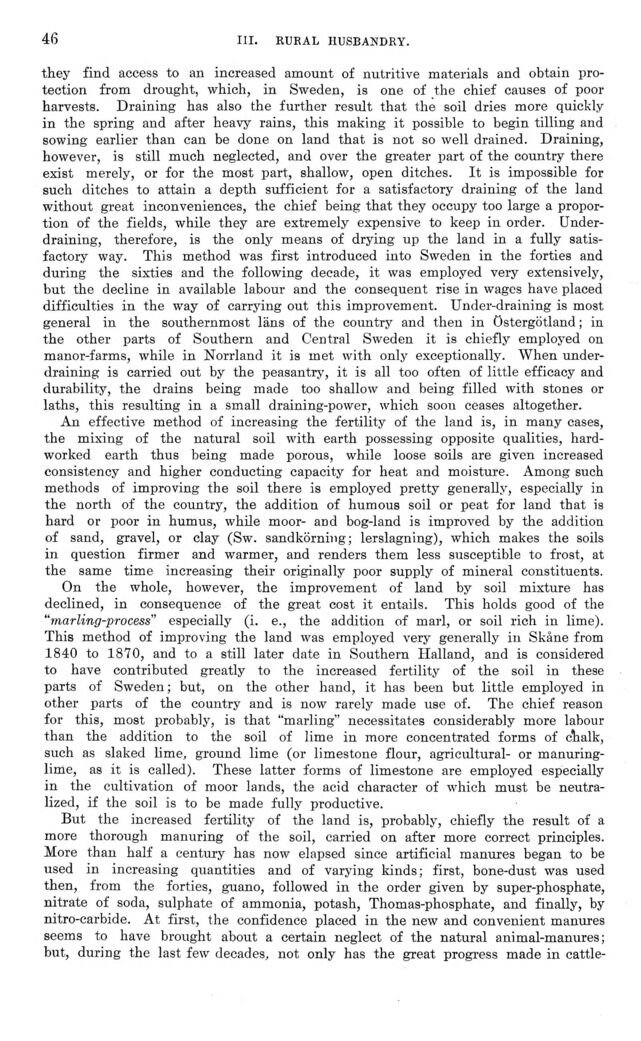
Full resolution (JPEG) - On this page / på denna sida - III. Rural Husbandry. Introd. by H. Juhlin Dannfelt - 1. Agriculture. By H. Juhlin Dannfelt

<< prev. page << föreg. sida << >> nästa sida >> next page >>
Below is the raw OCR text
from the above scanned image.
Do you see an error? Proofread the page now!
Här nedan syns maskintolkade texten från faksimilbilden ovan.
Ser du något fel? Korrekturläs sidan nu!
This page has never been proofread. / Denna sida har aldrig korrekturlästs.
46
III. RURAL HUSBANDRY.
they find access to an increased amount of nutritive materials and obtain
protection from drought, which, in Sweden, is one of the chief causes of poor
harvests. Draining has also the further result that the soil dries more quickly
in the spring and after heavy rains, this making it possible to begin tilling and
sowing earlier than can be done on land that is not so well drained. Draining,
however, is still much neglected, and over the greater part of the country there
exist merely, or for the most part, shallow, open ditches. It is impossible for
such ditches to attain a depth sufficient for a satisfactory draining of the land
without great inconveniences, the chief being that they occupy too large a
proportion of the fields, while they are extremely expensive to keep in order.
Under-draining, therefore, is the only means of drying up the land in a fully
satisfactory way. This method was first introduced into Sweden in the forties and
during the sixties and the following decade, it was employed very extensively,
but the decline in available labour and the consequent rise in wages have placed
difficulties in the way of carrying out this improvement. Under-draining is most
general in the southernmost läns of the country and then in Östergötland; in
the other parts of Southern and Central Sweden it is chiefly emploj’ed on
manor-farms, while in Norrland it is met with only exceptionally. When
under-draining is carried out by the peasantry, it is all too often of little efficacy and
durability, the drains being made too shallow and being filled with stones or
laths, this resulting in a small draining-power, which soon ceases altogether.
An effective method of increasing the fertility of the land is, in many cases,
the mixing of the natural soil with earth possessing opposite qualities,
hard-worked earth thus being made porous, while loose soils are given increased
consistency and higher conducting capacity for heat and moisture. Among such
methods of improving the soil there is employed pretty generally, especially in
the north of the country, the addition of humous soil or peat for land that is
hard or poor in humus, while moor- aDd bog-land is improved by the addition
of sand, gravel, or clay (Sw. sandkörning; lerslagning), which makes the soils
in question firmer and warmer, and renders them less susceptible to frost, at
the same time increasing their originally poor supply of mineral constituents.
On the whole, however, the improvement of land by soil mixture has
declined, in consequence of the great cost it entails. This holds good of the
"marling-process" especially (i. e., the addition of marl, or soil rich in lime).
This method of improving the land was employed very generally in Skåne from
1840 to 1870, and to a still later date in Southern Halland, and is considered
to have contributed greatly to the increased fertility of the soil in these
parts of Sweden; but, on the other hand, it has been but little employed in
other parts of the country and is now rarely made use of. The chief reason
for this, most probably, is that "marling" necessitates considerably more labour
than the addition to the soil of lime in more concentrated forms of chalk,
such as slaked lime, ground lime (or limestone flour, agricultural- or
manuring-lime, as it is called). These latter forms of limestone are employed especially
in the cultivation of moor lands, the acid character of which must be
neutralized, if the soil is to be made fully productive.
But the increased fertility of the land is, probably, chiefly the result of a
more thorough manuring of the soil, carried on after more correct principles.
More than half a century has now elapsed since artificial manures began to be
used in increasing quantities and of varying kinds; first, bone-dust was used
then, from the forties, guano, followed in the order given by super-phosphate,
nitrate of soda, sulphate of ammonia, potash, Thomas-phosphate, and finally, by
nitro-carbide. At first, the confidence placed in the new and convenient manures
seems to have brought about a certain neglect of the natural animal-manures;
but, during the last few decades, not onty has the great progress made in cattle-
<< prev. page << föreg. sida << >> nästa sida >> next page >>